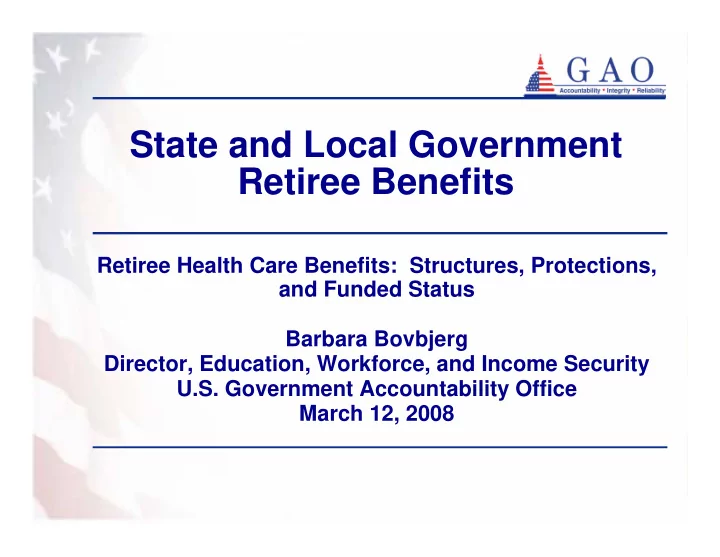

State and Local Government Retiree Benefits Retiree Health Care Benefits: Structures, Protections, and Funded Status Barbara Bovbjerg Director, Education, Workforce, and Income Security U.S. Government Accountability Office March 12, 2008
Key systems for providing retiree benefits to state and local workers: • Pensions • Retiree Health Benefits • Mostly defined benefit • Extent of premium cost plans with a formula; once sharing varies widely and accrued cannot be benefit plans can change diminished. for current and future retirees. • Managed as operating • Managed as trusts with expenses along with other oversight by boards of employee benefits. trustees. • Pay-as-you-go — that is, • Prefunded—that is, monies paid from annual operating are set aside and invested. funds as costs are incurred.
Group health coverage for retirees is widely available with varying levels of employer support Percentage of Premium Paid by Employer for Health Insurance Coverage for Retirees under Age 65 (Pre-Medicare-Eligible), by State in 2006 • Laws provide less protection for retiree health benefits. • Retiree health benefits are subject to change. Retiree health benefits are treated as an operating expense . •
Funding Status of Pensions and OPEB • The funded status of state and local governments pensions is reasonably sound. • Unfunded liabilities for retiree health benefits are significant • Compared to the future payments for pension benefits, payments for health care benefits are significantly more unpredictable because projecting future costs of health care is difficult. • Unfunded liabilities for retiree health benefits are high because unlike pension plans, nearly all state and local government retiree health benefits have been financed on a pay-as-you-go-basis. • Studies indicate that total retiree health benefits for all state and local governments have liabilities of between $600 billion and $1.6 trillion. • Other post-employment benefits—dental, vision, life insurance—are often funded primarily, if not entirely, by the beneficiary.
State and local governments have not prefunded retiree health benefits for several reasons: • Retiree health benefits viewed as an extension of active employee health care benefits. • Retiree health benefits were established at a time when health care costs were more affordable. • Given that retiree health benefits are generally not guaranteed by law, employers are freer to modify benefits. • The inflation rate for health care is not predictable. • Changes in national health care policy and health insurance markets can affect what benefits state and local governments cover.
GAO Simulation of Fiscal Outlook for the State and Local Sector • For pensions, our simulation shows that the current contribution rates are generally on track but could still fall short of future pension needs. • We assumed a 5 percent rate of return on assets. • Our simulation is highly sensitive to rates of return. • Retiree health care costs could more than double as a percentage of salaries over the next several decades. • Currently retiree health benefits run about 2 percent of salaries. • Assuming that health care costs continue to rise faster than GDP, by 2050 retiree health care would grow to 5 percent of salaries.
GAO Simulation of Fiscal Outlook for the State and Local Sector Projected Health and Non-health Expenditures of State and Local Governments through 2050
Concluding Observations • Persistent fiscal challenges lie ahead for state and local governments. • The growth in health-related costs is a primary driver of these fiscal challenges, as is true with the federal sector. • State and local governments need to find strategies for dealing with unfunded pension and OPEB liabilities, which • will take time, • will require difficult choices that will made in the context of the sector’s overall fiscal outlook, • could be affected by changes in national health policy.
GAO Work on Public Sector Retiree Benefits • Recent reports: • State and Local Government Retiree Benefits: Current Status of Benefit Structures, Protections, and Fiscal Outlook for Funding Future Costs. (GAO-07- 1156). September 24, 2007. • State and Local Government Retiree Benefits: Current Funded Status of Pension and Health Benefits. (GAO-08-223). January 29, 2008. • Ongoing work: • Options for State and Local Government Funding of Retiree Health Benefits.
Contact Us Barbara Bovbjerg, Director, Education, Workforce, and Income Security, bovbjergb@gao.gov See GAO’s Web site for copies of GAO products, www.gao.gov
Recommend
More recommend